Plant Health – international trade and controlled consignments, 2014-2018 - experimental stats publication (html version)
Updated 19 November 2020
These statistics present an analysis of international trade in plant and plant commodities[footnote 1] (including live plants, fruit, vegetables and cereals) – covering both the financial value and the physical scale (mass) of this trade. This release also presents an analysis of the notifications of controlled commodities – i.e., where checks are carried out to ensure that traded goods meet required standards. Data cover the period 2014 to 2018 (Forestry Commission data cover 2014/15-2018/19). Geographical coverage is specified at the start of each section.
Key findings
- During the period 2014-2018 the overall value of trade in plants and plant commodities increased while the net mass decreased. Such trends were not always linear due to the volatile nature of the trade, which can be affected by climate events, pest and disease and other factors.
- In 2018, imports accounted for 90.3 per cent of all trade value and 84.5 per cent of net mass of trade in plants and plant commodities.
- The value of trade in plant and plant commodities between the UK and the European Union increased between 2014 and 2018, however the corresponding net mass decreased. The value of trade with non-EU countries increased while the net mass remained stable between 2014 and 2018.
- In 2018, over 109,000 consignments of controlled material were notified to the Plant Health and Seeds Inspectorate (PHSI), an increase of just under 30 per cent since 2014. Over half of these consignments originated in Africa.
- In 2018/19, over 3,900 consignments of controlled material were notified to the Forestry Commission. The number of consignments was slightly higher (+50) than in 2014/15 while the volume of material in the consignments also increased (+68,487m).
Contents
Trade in plants and plant products
Plant Health and Seeds Inspectorate
Introduction
Plants are environmentally, economically, and socially important, providing a vital contribution to our food and timber supply and to the rural economy. Plants also perform an essential ecosystem service in shaping the landscape and supporting biodiversity and have been linked to improved health and wellbeing[footnote 2].
The globalisation of trade has facilitated an increase in the volume and diversity of plants and plant commodities which enter the UK. This trade generates economic value but also needs to be regulated (controlled), noting the links, along with other factors, to increased risk of pest and disease[footnote 3].
Hence plant health legislation[footnote 4] controls the import and movement of certain plants, trees, seeds and organic matter - such as soil - and certain plant products, including fruit, potatoes, vegetables, cut flowers, timber, foliage and grain.
The analysis below explores both the overall UK trade in plants and plant commodities, and also the trade in regulated plant health and forestry commodities which informs the inspections undertaken by the Plant Health and Seeds Inspectorate (PHSI) and the Forestry Commission (FC) to prevent plant pests and diseases from entering England and Wales, and, for Forestry Commission, Scotland[footnote 5].
Please note that the three datasets explored in this publication are not directly comparable. There are key differences in how each dataset is compiled and these are outlined further in the accompanying quality and methodology report.
Experimental Statistics
This statistical release is intended as a contribution to increasing wider understanding about trade in these commodities and about plant health. It is designed to provide stakeholders, internal and external to government, with information on the patterns of trade over time for a specific set of commodities. The primary aim is to facilitate discussion and aid decision making around biosecurity.
The release is not intended for the purpose of drawing inferences as to the effectiveness of plant health and forestry inspectorates.
New statistical releases are classified as experimental statistics in order to secure feedback from users – for example about the long-term need for the information (the user value) and the technical fitness for purpose (the quality). If you have any comments or feedback on this release – or about other needs for formal statistics in policy areas of trade and biosecurity - please contact
Sam Grant,
Plant Health Statistics,
Horizon House,
Deanery Rd,
Bristol
BS1 5TL.
Guidance on Experimental Statistics
Trade in plants and plant products
Her Majesty’s Revenue and Customs (HMRC) compiles statistics on commodities physically leaving and entering the UK, traded with both European Union (EU) Member States and non-EU countries. Non-EU trade is collected from customs declarations. EU trade is collected via Intrastat which covers VAT-registered businesses whose annual value of arrivals and/or dispatches exceeds a given exemption threshold[footnote 6]
Although not collected for plant health purposes the HMRC data does allow us to examine the patterns of trade for a sub-section of commodities, i.e., raw and simply processed plants and plant commodities, and to group these into categories. The categories covered in this release are:
- Plants and planting material. This category includes bulbs, plants for planting, forest tree seed and cut flowers.
- Food and crops. This category includes fruit, vegetables, cereals, nuts, herbs and spices.
- Forestry: This category includes timber (unprocessed or simply processed: sliced, planed or chipped), packing cases, casks and barrels.
Table 1: Value of trade in plants and plant commodities, by sector, 2014-2018
| Sector | 2014 | 2015 | 2016 | 2017 | 2018 | Value change 2014 to 2018 | Percentage change 2014 to 2018 |
|---|---|---|---|---|---|---|---|
| Imports | |||||||
| Plants and planting material | 1,200 | 915 | 1,018 | 1,045 | 1,003 | -197 | -16.4 |
| Food and crops | 8,292 | 8,067 | 8,981 | 9,857 | 9,742 | 1,450 | 17.5 |
| Forestry | 1,887 | 1,637 | 1,708 | 1,933 | 2,070 | 183 | 9.7 |
| Total | 11,379 | 10,619 | 11,707 | 12,835 | 12,815 | 1,435 | 12.6 |
| Exports | |||||||
| Plants and planting material | 101 | 91 | 103 | 119 | 123 | 21 | 21.1 |
| Food and crops | 1,170 | 1,254 | 1,494 | 1,112 | 1,065 | -105 | -9.0 |
| Forestry | 154 | 142 | 144 | 170 | 186 | 32 | 21.1 |
| Total | 1,425 | 1,487 | 1,742 | 1,401 | 1,374 | -51 | -3.6 |
| All trade | |||||||
| Plants and planting material | 1,302 | 1,006 | 1,122 | 1,164 | 1,126 | -176 | -13.5 |
| Food and crops | 9,461 | 9,321 | 10,475 | 10,970 | 10,806 | 1,345 | 14.2 |
| Forestry | 2,041 | 1,779 | 1,852 | 2,103 | 2,256 | 215 | 10.5 |
| Total | 12,804 | 12,106 | 13,449 | 14,237 | 14,188 | 1,384 | 10.8 |
Table 1 shows the total value of trade in plants and plant commodities, by sector, between 2014 and 2018.
-
The total value of trade in plants and plant commodities has shown a broad upward trend over the time period however the level remained similar in 2017 and 2018. Trade in plants and planting material was the only sector to show a decrease in total trade, despite the value of exports in this sector (£123m) being at the highest of the time period in 2018.
-
The import value of the plants and planting materials sector has remained around £1bn for the last three years, following a drop from the high level (£1.2bn) recorded in 2014.
-
The total value of exports of plants and plant commodities decreased from £1,425m to £1,374m between 2014 and 2018. This was driven by a decrease in the value of the food and crops sector where exports over the last two years were at the lowest level of the time period.
Table 2: Net mass of trade in plants and plant commodities, by sector, 2014-2018
| Sector | 2014 | 2015 | 2016 | 2017 | 2018 | Value change 2014 to 2018 | Percentage change 2014 to 2018 |
|---|---|---|---|---|---|---|---|
| Imports | |||||||
| Plants and planting material | 443 | 347 | 351 | 388 | 358 | -85 | -19.3 |
| Food and crops | 12,854 | 11,889 | 11,707 | 12,939 | 13,077 | 223 | 1.7 |
| Forestry | 4,558 | 4,107 | 4,154 | 4,321 | 4,521 | -38 | -0.8 |
| Total | 17,855 | 16,343 | 16,212 | 17,647 | 17,955 | 100 | 0.6 |
| Exports | |||||||
| Plants and planting material | 47 | 36 | 44 | 55 | 48 | 0 | 1.0 |
| Food and crops | 3,821 | 5,059 | 6,229 | 3,031 | 2,487 | -1,334 | -34.9 |
| Forestry | 1,227 | 1,091 | 784 | 809 | 761 | -466 | -38.0 |
| Total | 5,095 | 6,186 | 7,057 | 3,895 | 3,296 | -1,799 | -35.3 |
| All trade | |||||||
| Plants and planting material | 491 | 384 | 395 | 443 | 406 | -85 | -17.3 |
| Food and crops | 16,675 | 16,949 | 17,937 | 15,970 | 15,564 | -1,111 | -6.7 |
| Forestry | 5,785 | 5,198 | 4,938 | 5,130 | 5,281 | -504 | -8.7 |
| Total | 22,951 | 22,530 | 23,269 | 21,542 | 21,251 | -1,700 | -7.4 |
Table 2 shows the total net mass of trade in plants and plant commodities, by sector, between 2014 and 2018.
-
All sectors saw a decrease in the net mass of trade over the period 2014-2018 with plants and planting materials seeing the greatest decrease (-17.3 per cent) despite the net mass of exports for this sector remaining at a similar level in 2018 as in 2014.
-
During the time period 2014 to 2018, the total net mass of imports remained fairly stable but the net mass of exports decreased by around a third.
-
Decreases in the net mass of imports in the plants and planting material and forestry sectors were offset by a small increase in the net mass of food and crops imports meaning overall import levels remained fairly stable over the time period.
-
The net mass of exports of plants and plant commodities decreased to 3,296 thousand tonnes in 2018 after reaching a high of 7,057 thousand tonnes in 2016 (35.3 per cent decrease between 2014 and 2018).
Figure 1: Changes in international trade of plants and plant commodities, 2014-2018
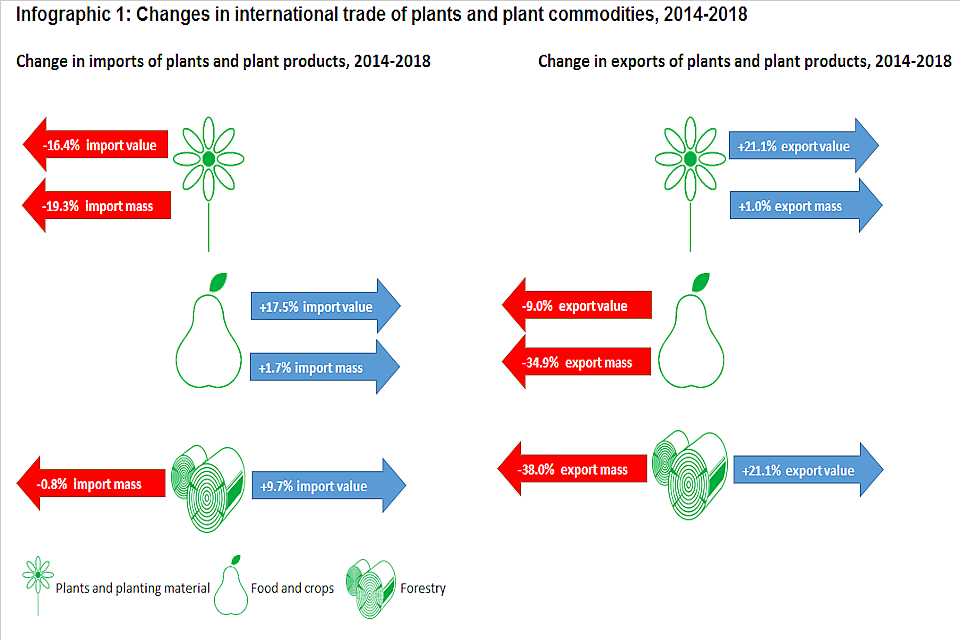
Figure 1: Changes in international trade of plants and plant commodities, 2014-2018. Infographic shows flows for plants and planting materials, food and crops, and forestry.
Table 3: Value of UK-EU trade in plants and plant commodities, by sector, 2014-2018
| Sector | 2014 | 2015 | 2016 | 2017 | 2018 | Value change 2014 to 2018 | Percentage change 2014 to 2018 |
|---|---|---|---|---|---|---|---|
| EU Imports | |||||||
| Plants and planting material | 1,012 | 737 | 838 | 858 | 811 | -202 | -19.9 |
| Food and crops | 4,230 | 3,884 | 4,306 | 4,679 | 4,670 | 440 | 10.4 |
| Forestry | 1,448 | 1,181 | 1,262 | 1,480 | 1,628 | 180 | 12.4 |
| Total | 6,690 | 5,803 | 6,406 | 7,016 | 7,108 | 418 | 6.2 |
| EU Exports | |||||||
| Plants and planting material | 82 | 70 | 82 | 92 | 96 | 14 | 17.7 |
| Food and crops | 880 | 921 | 1,124 | 914 | 888 | 8 | 0.9 |
| Forestry | 124 | 104 | 110 | 132 | 147 | 23 | 18.8 |
| Total | 1,086 | 1,095 | 1,315 | 1,138 | 1,132 | 46 | 4.2 |
| All EU trade | |||||||
| Plants and planting material | 1,094 | 807 | 920 | 950 | 907 | -187 | -17.1 |
| Food and crops | 5,110 | 4,805 | 5,430 | 5,593 | 5,558 | 448 | 8.8 |
| Forestry | 1,572 | 1,285 | 1,372 | 1,611 | 1,775 | 203 | 12.9 |
| Total | 7,776 | 6,898 | 7,722 | 8,154 | 8,240 | 464 | 6.0 |
Table 3 shows the value of commodities that are imported into the UK from the EU and commodities that are exported from the UK to the EU, by sector.
-
In 2018, the total value of trade with the EU and also the total value of EU imports were at their highest levels during the time period 2014 to 2018. With the exception of imports and total trade in the sector of plants and planting material, all sectors and trade flows have seen an increase in the value of EU trade since 2014.
-
The value of EU imports in the plants and planting material sector decreased by around one fifth over the time period.
-
Total values for each trade flow (import/export/all) increased by between 4.2 and 6.2 per cent over the time period, however this masks larger changes in individual sectors, for example, the export value of both the forestry and plants and planting materials sectors increased by around 17-19 per cent over the time period.
Table 4: Net mass of UK-EU trade in plants and plant commodities, by sector, 2014-2018
| Sector | 2,014 | 2,015 | 2,016 | 2,017 | 2,018 | Value change 2014 to 2018 | Percentage change 2014 to 2018 |
|---|---|---|---|---|---|---|---|
| EU Imports | |||||||
| Plants and planting material | 357 | 276 | 283 | 326 | 293 | -64 | -18.0 |
| Food and crops | 6,949 | 6,384 | 5,959 | 6,338 | 6,376 | -573 | -8.2 |
| Forestry | 3,965 | 3,492 | 3,548 | 3,803 | 3,988 | 23 | 0.6 |
| Total | 11,270 | 10,152 | 9,790 | 10,467 | 10,657 | -613 | -5.4 |
| EU Exports | |||||||
| Plants and planting material | 37 | 30 | 37 | 32 | 41 | 4 | 11.8 |
| Food and crops | 2,708 | 3,604 | 4,473 | 2,646 | 2,164 | -544 | -20.1 |
| Forestry | 1,175 | 1,024 | 725 | 723 | 678 | -497 | -42.3 |
| Total | 3,919 | 4,657 | 5,236 | 3,401 | 2,883 | -1,036 | -26.4 |
| All EU trade | |||||||
| Plants and planting material | 393 | 306 | 320 | 358 | 334 | -60 | -15.2 |
| Food and crops | 9,657 | 9,988 | 10,432 | 8,984 | 8,540 | -1,116 | -11.6 |
| Forestry | 5,139 | 4,516 | 4,274 | 4,526 | 4,666 | -473 | -9.2 |
| Total | 15,189 | 14,809 | 15,025 | 13,868 | 13,540 | -1,650 | -10.9 |
Table 4 shows commodities that are imported into the UK from the EU and commodities that are exported from the UK to the EU, by sector.
-
All sectors experienced a decrease overall in total EU trade, with levels 10.9 per cent lower in 2018 than in 2014.
-
The total net mass of imports of plants and plant commodities from the EU decreased slightly between 2014 and 2018 (-5.4 per cent) with forestry the only sector where import net mass remained stable.
-
The total net mass of exports of plants and plant commodities to the EU was at its lowest level of the time period in 2018 (2,883 thousand tonnes), standing at just over half of the net mass seen in 2016 (5,236 thousand tonnes). Plants and planting materials was the only sector to see an increase in the net mass of exports (+4 thousand tonnes) during the time period.
Charts 1a and 1b: Distribution of UK-EU trade in plants and plant commodities, 2014-2018
1.a. Value
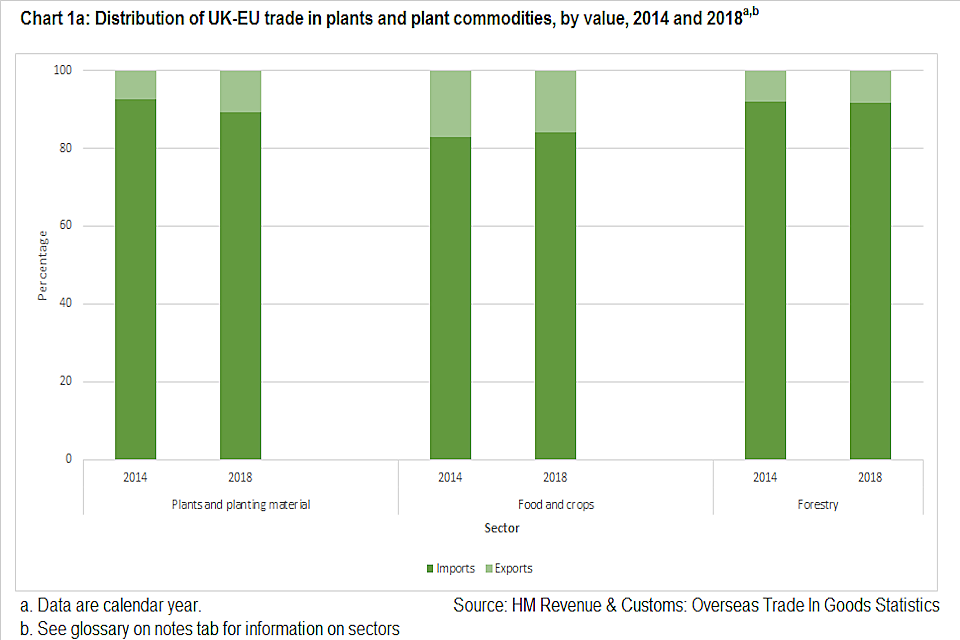
Chart 1a: Distribution of UK-EU trade in plants and plant commodities, by value, 2014 and 2018. Categories are Plants and planting material, Food and crops, Forestry. Data are calendar year. Source: HMRC, Overseas Trade In Goods Statistics.
1.b. Net Mass
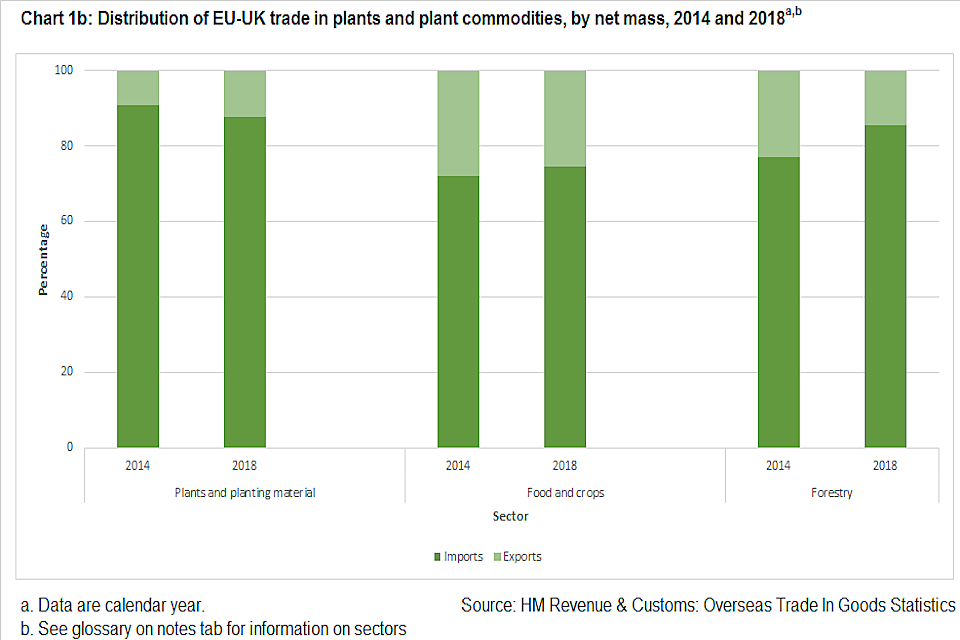
Chart 1b: Distribution of UK-EU trade in plants and plant commodities, by net mass, 2014 and 2018. Categories are Plants and planting material, Food and crops, Forestry. Data are calendar year. Source: HMRC, Overseas Trade In Goods Statistics.
-
The proportion of EU trade value that was imports was higher for plants and planting material and forestry (over 90 per cent) than for food and crops (over 80 per cent).
-
The proportion of trade value in food and crops that was imports increased between 2014 and 2018 (+1.2 percentage points) whilst the proportion of trade that was imports of plants and planting material or forestry decreased slightly (-3.1 and -0.4 percent respectively).
-
In terms of the net mass of EU trade, the picture was similar for plants and planting material as for value. For both food and crops and forestry the proportion of net mass that was imports was lower than for their respective trade value however forestry showed a 8.3 percentage point increase between 2014 and 2018).
Table 5: Value of UK-non-EU trade in plants and plant commodities, by sector, 2014-2018
| Sector | 2014 | 2015 | 2016 | 2017 | 2018 | Value change 2014 to 2018 | Percentage change 2014 to 2018 |
|---|---|---|---|---|---|---|---|
| Non-EU Imports | |||||||
| Plants and planting material | 188 | 178 | 180 | 187 | 193 | 5 | 2.4 |
| Food and crops | 4,062 | 4,183 | 4,675 | 5,178 | 5,072 | 1,010 | 24.9 |
| Forestry | 439 | 456 | 446 | 453 | 442 | 3 | 0.6 |
| Total | 4,689 | 4,817 | 5,301 | 5,819 | 5,706 | 1,018 | 21.7 |
| Non-EU Exports | |||||||
| Plants and planting material | 20 | 20 | 22 | 26 | 27 | 7 | 35.4 |
| Food and crops | 289 | 333 | 370 | 199 | 176 | -113 | -39.2 |
| Forestry | 30 | 38 | 34 | 39 | 39 | 9 | 30.8 |
| Total | 339 | 392 | 427 | 263 | 241 | -97 | -28.7 |
| All non-EU trade | |||||||
| Plants and planting material | 208 | 199 | 202 | 213 | 219 | 11 | 5.5 |
| Food and crops | 4,351 | 4,516 | 5,045 | 5,377 | 5,248 | 897 | 20.6 |
| Forestry | 469 | 494 | 480 | 492 | 481 | 12 | 2.5 |
| Total | 5,028 | 5,208 | 5,727 | 6,082 | 5,948 | 920 | 18.3 |
Table 5 shows the value of commodities that are imported into the UK from countries outside of the EU and commodities that are exported from the UK to these non-EU countries, by sector.
-
The total value of non-EU trade increased for all sectors between 2014 and 2018. For the food and crops sector, the total trade value increased by around one fifth despite a decrease in the value of exports (-39.2 per cent since 2014).
-
The 2018 non-EU export value of £176m in the food and crops sector was less than half of the value for this sector in 2016 (£370m).
-
The value of non-EU imports in the forestry and plants and planting material sectors remained fairly stable over the time period 2014-2018 whilst the value of exports in both sectors increased.
Table 6: Net mass of non-EU trade in plants and plant commodities, 2014-2018
| Sector | 2014 | 2015 | 2016 | 2017 | 2018 | Value change 2014 to 2018 | Percentage change 2014 to 2018 |
|---|---|---|---|---|---|---|---|
| Non-EU Imports | |||||||
| Plants and planting material | 86 | 71 | 68 | 62 | 65 | -21 | -24.7 |
| Food and crops | 5,905 | 5,505 | 5,748 | 6,601 | 6,700 | 795 | 13.5 |
| Forestry | 594 | 615 | 606 | 517 | 532 | -61 | -10.3 |
| Total | 6,585 | 6,191 | 6,422 | 7,180 | 7,298 | 713 | 10.8 |
| Non-EU Exports | |||||||
| Plants and planting material | 11 | 7 | 7 | 23 | 7 | -4 | -35.3 |
| Food and crops | 1,113 | 1,455 | 1,756 | 385 | 323 | -790 | -71.0 |
| Forestry | 52 | 67 | 58 | 86 | 83 | 31 | 59.2 |
| Total | 1,176 | 1,529 | 1,822 | 494 | 413 | -763 | -64.9 |
| All non-EU trade | |||||||
| Plants and planting material | 97 | 78 | 75 | 85 | 72 | -25 | -25.9 |
| Food and crops | 7,018 | 6,961 | 7,505 | 6,986 | 7,024 | 5 | 0.1 |
| Forestry | 646 | 682 | 664 | 604 | 615 | -31 | -4.7 |
| Total | 7,761 | 7,721 | 8,244 | 7,674 | 7,711 | -50 | -0.6 |
Table 6 shows the net mass of commodities that are imported into the UK from countries outside of the EU and commodities that are exported from the UK to these non-EU countries, by sector.
-
Overall, the net mass of the non-EU annual trade in plants and plant commodities remained fairly stable between 2014 and 2018 at around 7,700 thousand tonnes. The exception to this was in 2016 when net mass reached a peak of 8,244 thousand tonnes.
-
In 2018, the total net mass of non-EU imports of plants and plant commodities was at its highest level of the time period with 7,298 thousand tonnes of commodities imported. This was driven by an increase in the net mass of imports in the sector of food and crops while both the plants and planting material and forestry sectors experienced decreases in net mass.
-
The net mass of non-EU exports in the food and crops sector was over 5 times lower in 2018 than in 2016, when net mass was at its highest level of the time period, and over three times lower than in 2014. The decrease was largely driven by decreases in the net mass of wheat, meslin and barley, exported during 2018 and may reflect the weather conditions at the time as well as consumption in the UK during that period.
Chart 2a and 2b: Distribution of UK-non-EU trade in plants and plant commodities, 2014-2018
2.a. Value
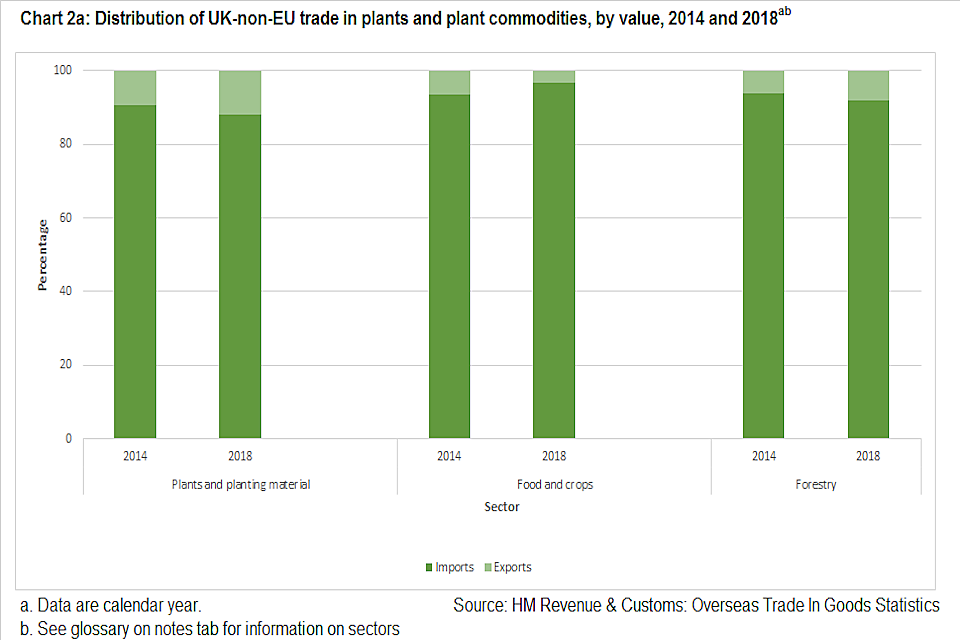
Chart 2a: Distribution of UK-non-EU trade in plants and plant commodities, by value, 2014-2018. Categories are Plants and planting material, Food and crops, Forestry. Data are calendar year. Source: HMRC, Overseas Trade In Goods Statistics.
2.b. Net Mass
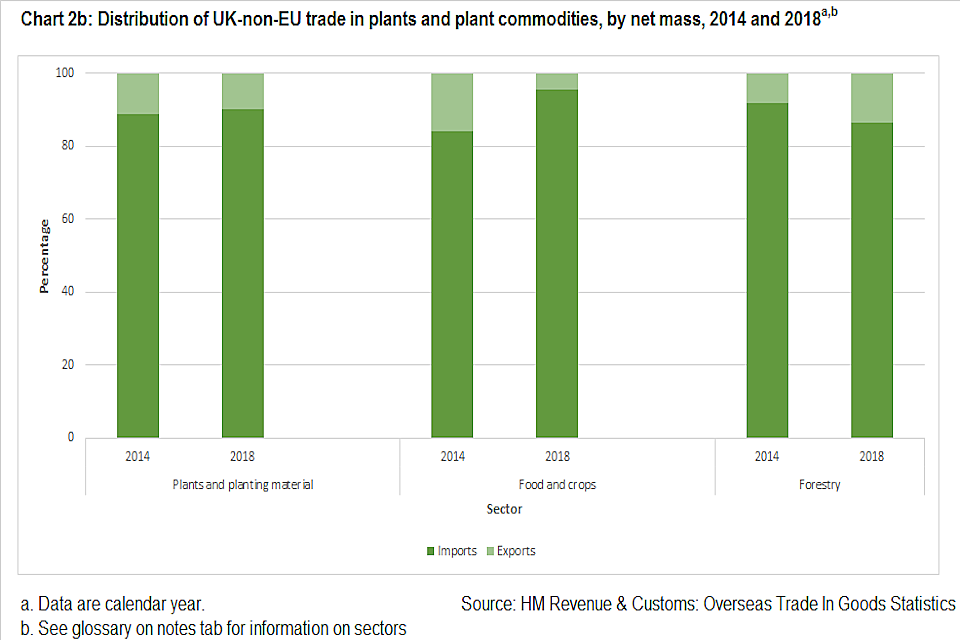
Chart 2b: Distribution of UK-non-EU trade in plants and plant commodities, by net mass, 2014-2018. Categories are Plants and planting material, Food and crops, Forestry. Data are calendar year. Source: HMRC, Overseas Trade In Goods Statistics.
-
Imports accounted for over 90 per cent of all non-EU trade value in all sectors in 2014. In 2018 imports as a proportion of the trade in a sector had increased for food and crops (+3.3 percentage points) but decreased for plants and planting material (-2.7 percentage points) and for forestry (-1.7 percentage points).
-
The net mass of non-EU trade saw imports increase their share of trade in the sectors of plants and planting material and food and crops. For the food and crops sector the share of trade that was imports increased by 11.3 percentage points from 84.1 per cent in 2014 to 95.4 per cent in 2018.
Figure 2: Changes in trade of plants and plant commodities between 2014-2018, by area
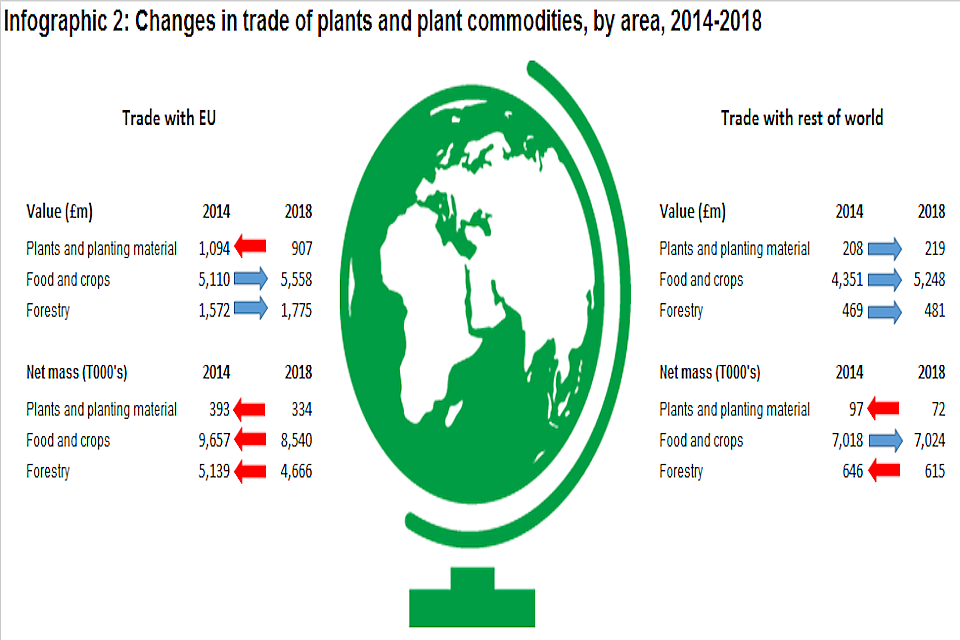
Infographic 2: Changes in trade of plants and plant commodities between 2014-2018, by area. Infographic shows value and net mass of trade with EU and with rest of world.
Controlled Commodities
The Plant Health and Seeds Inspectorate (PHSI) implements and enforces plant health policy in England and in Wales (on behalf of the Welsh Government). The Forestry Commission (FC) implements and enforces plant health policy in England and Scotland, and in Wales via Natural Resources Wales (NRW).
PHSI and FC carry out inspections of controlled plant materials, including plants for planting. The controls of such materials differ according to the species - and what quarantine organisms they may carry – but may include phytosanitary certificates, plant passports and/or physical inspection. Information on the volume of inspections is available in the annual Multi Annual National Control Plan[footnote 8]. Information covering interceptions of material that does not meet EU phytosanitary requirements is published in the annual Europhyt report [footnote 9].
Plants, fruit, vegetables and plant material from outside the EU[footnote 10] fall into 3 categories:
- ‘unrestricted’ material you can bring to the UK without any conditions;
- ‘controlled’ material that you can only bring into the UK with a ‘phytosanitary certificate’ to show it meets the requirements for entry to the EU;
- ‘prohibited’ material you can’t bring into the UK unless you get a scientific research licence or an exception (‘derogation’) to the rules.
Moving controlled plants or plant commodities in the EU[footnote 11] requires a plant passport with which commodities can move freely within the EU. Inspections of relevant businesses are carried out ‘in field’, generally between 2 and 4 times per year, depending on the business’s risk to plant health.
For trade with countries outside of the EU, plant health checks are made at approved points of entry into Great Britain (England and Wales for PHSI, England, Wales and Scotland for FC). To gain approved status, a port or airport authority must provide certain minimum conditions necessary to ensure that inspections can be carried out efficiently and safely and, in the event that it becomes necessary, relevant material can be treated or destroyed.
The analyses below focuses on consignments of commodities classed as controlled and originating outside the EU and arriving at points of entry in Great Britain (England and Wales for PHSI, England, Wales and Scotland for FC). These consignments are subject to inspection activities ranging from document checks to physical inspections. The level of checks required for different types of commodities can be considered as full (100 per cent) or reduced [footnote 12] . In addition, emergency measures [footnote 13] can be introduced which may restrict trade due to changes in import requirements. All controlled Forestry commodities are required to be checked (100 per cent).
Controlled commodities are a subset of the trade analysis shown above (which also includes unrestricted commodities), however data are not comparable to that provided by HMRC due to differences in measurement units, geographies and purpose. More information can be found in the accompanying quality and methodology report.
Where geographical breakdowns are provided for PHSI and FC, these use United Nations Statistics Division classifications. https://unstats.un.org/unsd/methodology/m49/
Plant Health and Seeds Inspectorate
The Plant Health and Seeds Inspectorate (PHSI) is part of the Animal and Plant Health Agency (APHA) and implements and enforces plant health policy in England, and in Wales on behalf of the Welsh Government. PHSI carry out inspections of plants, seeds, bulbs, cut flowers, planting materials, fruits and vegetables. They also inspect agricultural machinery for export however such trade is not covered in this analysis.
It is important to note that changes in the number of consignments may be influenced by changes in trade patterns as well as by legislative changes. Factors which can contribute to changes in trade patterns include climate events, changes in market demand, social unrest or change, pest outbreaks etc. Controls may be applied to any number of countries where there is a pest risk but additionally countries may apply self-prohibition if they are aware of a pest issue in their country. Where self-prohibition is applied there are no formal reporting routes and often information cannot be confirmed.
Some key bans thought to have affected imports to the UK were:
- India: Colocasia Schott and plants other than seeds of Momordica L., Solanum melongena L. and Trichosanthes L. and Mangifera were banned from 24/04/2014 until 31/12/2016 with the exception of Trichosanthes L. and Mangifera for which the ban was lifted in February 2016.
- Ghana: Capsicum L., Lagenaria Ser., Luffa Mill., Momordica L. and Solanum L., other than S. lycopersicum L. were banned from 13/10/2017 until 31/12/2017.
- Trade in fresh curry leaves was stopped from 26/04/2014 due to countries outside of the EU being unable to meet EU requirements.
- EU Directive 2017/1279 requires tomatoes originating from all third countries (outside the EU but including Canary Islands, Ceuta, Melilla and the French Overseas Departments) and pomegranates originating from countries of the African continent, Cape Verde, Saint Helena, Madagascar, La Reunion, Mauritius and Israel to be imported with a phytosanitary certificate.
- There has been self-imposed bans from Thailand, Bangladesh and Vietnam.
New controls being introduced may also impact trade patterns. For example, decision 2014/78 required all imports of Capsicum to become regulated as from 1st Oct 2014. The decision also included the application of controls on some other commodities.
Table 7: Number of controlled consignments, by commodity type, 2014-2018
| Year | Plants and planting material | Fruit | Vegetables | Other commodities | Total |
|---|---|---|---|---|---|
| 2014 | 26,272 | 43,825 | 12,438 | 1,792 | 84,327 |
| 2015 | 27,512 | 44,352 | 22,761 | 2,522 | 97,147 |
| 2016 | 28,802 | 47,542 | 24,357 | 2,476 | 103,177 |
| 2017 | 27,534 | 47,919 | 24,550 | 2,196 | 102,199 |
| 2018 | 27,948 | 55,280 | 23,478 | 2,474 | 109,180 |
| Value change 2014-2018 | 1,676 | 11,455 | 11,040 | 682 | 24,853 |
| Percentage change 2014-2018 | 6.4 | 26.1 | 88.8 | 38.1 | 29.5 |
Table 7 shows the number of controlled consignments notified to PHSI, by commodity type.
-
Overall, the number of controlled consignments increased by 29.5 per cent with increases across all groups of commodities between 2014 and 2018.
-
Between 2014 and 2018 the number of controlled consignments of vegetables increased by 88.8 per cent despite a small decrease between 2017 and 2018. The largest increase was seen between 2014 and 2015 and was likely the result of controls on capsicum coming into force.
-
The number of controlled consignments of fruit increased by over a quarter (26.1 per cent) with this type of product experiencing year-on-year increases.
Chart 3: Controlled consignments by commodity type, 2014-2018

Chart 3: Controlled consignments by commodity type, 2014-2018. Chart shows percentages for Plants and planting material, Fruit, Vegetables, and Other commodities, for each year between 2014 and 2018. Source: Plant Health and Seeds Inspectorate.
-
Controlled consignments of fruit accounted for half of all consignments in 2018 while plants and planting material accounted for a further quarter.
-
The proportion of controlled consignments that were vegetables increased by 6.8 percentage points between 2014 and 2018 whilst the proportion that were plants and planting material decreased by 5.6 percentage points.
Table 8: Number of controlled consignments, by region of origin, 2014-2018
| Year | Africa | Americas | Asia | Europe (non-EU) | Oceania | Total |
|---|---|---|---|---|---|---|
| 2014 | 44,620 | 21,940 | 15,395 | 102 | 2,270 | 84,327 |
| 2015 | 52,679 | 20,335 | 21,695 | 96 | 2,342 | 97,147 |
| 2016 | 54,720 | 21,321 | 24,934 | 122 | 2,080 | 103,177 |
| 2017 | 54,998 | 21,354 | 23,361 | 121 | 2,365 | 102,199 |
| 2018 | 59,315 | 22,980 | 23,520 | 1,076 | 2,289 | 109,180 |
| Value change 2014-2018 | 14,695 | 1,040 | 8,125 | 974 | 19 | 24,853 |
| Percentage change 2014-2018 | 32.9 | 4.7 | 52.8 | 954.9 | 0.8 | 29.5 |
Table 8 shows the number of controlled consignments notified to PHSI, by region of origin.
- Controlled consignments from European (non-EU) countries were over 10 times higher in 2018 than in 2014. This followed the introduction of controls on tomatoes from non-EU countries as of January 2018.
- Controlled consignments originating in Asia increased by over 50 per cent between 2014 and 2018 however levels remained fairly stable in 2017 and 2018.
- Trade from the Americas and from Oceania has remained fairly stable over the time period 2014 to 2018 while trade from Africa has shown a year-on-year increase.
Chart 4: Controlled consignments by region of origin, 2014-2018
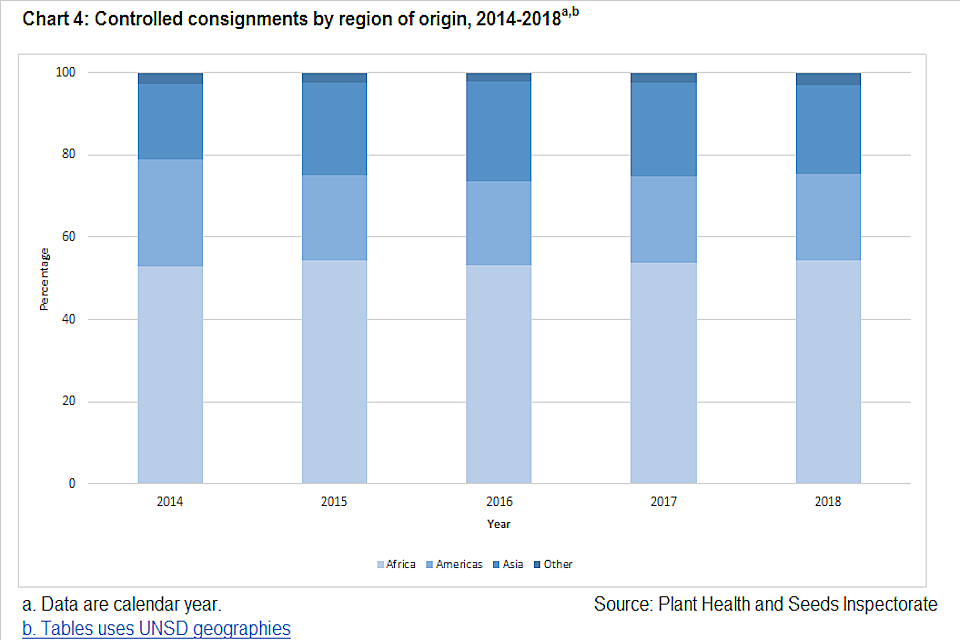
Chart 4: Controlled consignments by region of origin, 2014-2018. Chart shows percentages of consignments from Africa, Americas, Asia, and Other, for each year from 2014 to 2018. Source: Plant Health and Seeds Inspectorate.
- Controlled consignments originating in Africa represented just over half of all controlled consignments in each year shown.
- The Americas and Asia were each responsible for around one fifth of all controlled consignments in 2018. The proportions of controlled consignments for Asia increased (+3.3 percentage points) since 2014 while decreasing for the Americas (-5.0 percentage points).
Forestry Commission
The Forestry Commission (FC) are responsible for inspections of timber, including sawn timber, wood shavings, wood chips, sawdust and prefabricated buildings made of wood being imported to England, Scotland and Wales. The Forestry Commission are also responsible for inspections of wood packaging and controlled firewood[footnote 14] however these trades are not covered in this release.
Controlled forestry commodities are required to undergo full checks (100 per cent) thus the number of consignments is also the number of inspections.
It is important to note that changes in the number of consignments may be influenced by changes in trade patterns as well as by legislative changes. Factors which can contribute to changes in trade patterns include climate events, changes in market demand, social unrest or change, pest outbreaks etc. Controls may be applied to any number of countries where there is a pest risk but additionally countries may apply self-prohibition if they are aware of a pest issue in their country.
Chart 5a and 5b: Controlled consignments by timber type, 2014/15-2018/19
5a Number of consignments
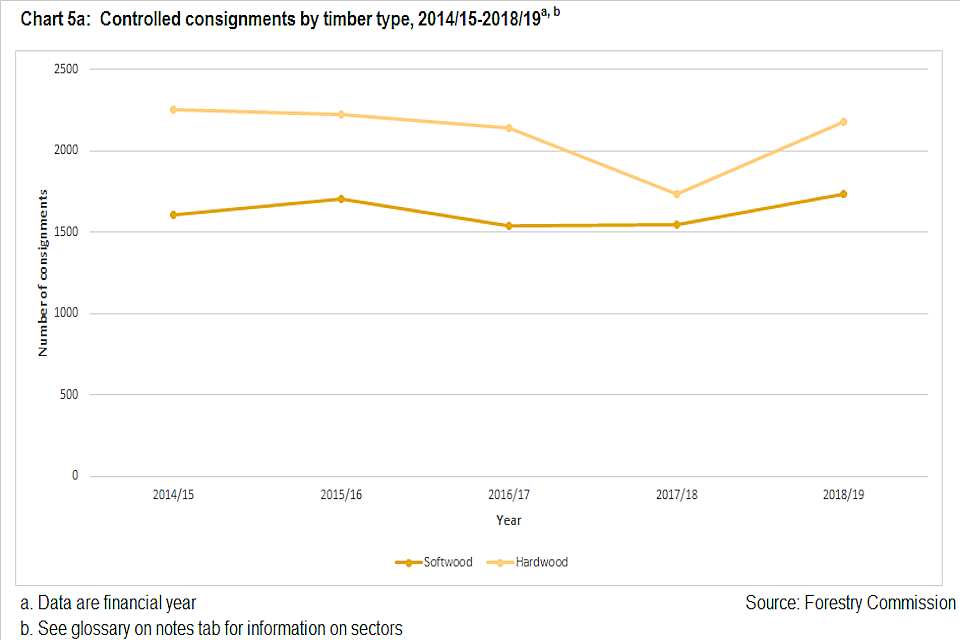
Chart 5a: Controlled consignments by timber type, 2014/15-2018/19, number of consignments. Data are financial year, show softwood and hardwood number of consignments for each year between 2014/15 and 2018/19. Source: Forestry Commission.
5b. Volume of material

Chart 5b: Controlled consignments by timber type, 2014/15-2018/19, volume of material. Data are financial year, show softwood and hardwood number of consignments for each year between 2014/15 and 2018/19. Source: Forestry Commission.
- The number of controlled consignments of hardwood saw a year-on-year decrease from 2,256 in 2014/15 to 1,738 in 2017/18 before increasing to 2,175 in 2018/19. The number of controlled consignments of softwood increased from 1,604 to 1,735 over the time period.
- The volume of material in controlled consignments of hardwood increased from 128,195m3 in 2014/15 to 190,337m3 in 2018/19 while softwood increased from 381,028m3 in 2014/15 to 387,373m3 in 2018/19.
- Hardwood consignments accounted for 58.4 per cent of all controlled consignments in 2014/15 but decreased to 55.6 per cent in 2018/19.
- The volume of hardwood accounted for around 25.2 per cent of the total volume of controlled consignments in 2014/15 but increased to 32.9 per cent in 2018/19.
Table 9: Controlled consignments of softwood, by region of origin, 2014/15-2018/19
| 2014/15 | 2015/16 | 2016/17 | 2017/18 | 2018/19 | Value change 2014-2018 | Percentage change 2014-2018 | |
|---|---|---|---|---|---|---|---|
| Number of consignments | |||||||
| Africa | - | - | - | - | 4 | 4 | n/a |
| Asia | - | * | 8 | 15 | 13 | 13 | n/a |
| Australia and New Zealand | 22 | 19 | 13 | 21 | 49 | 27 | 122.7 |
| Central and South America | 39 | 52 | 32 | 32 | 41 | 2 | 5.1 |
| North America | 1,102 | 1,169 | 1,030 | 1,108 | 1,036 | -66 | -6.0 |
| Europe (non-EU) | 441 | 466 | 453 | 367 | 592 | 151 | 34.2 |
| Total | 1,604 | 1,706 | 1,536 | 1,543 | 1,735 | 131 | 8.2 |
| Volume of notified product (m3) | |||||||
| Africa | - | - | - | - | 200 | 200 | n/a |
| Asia | - | * | 278 | 532 | 392 | 392 | n/a |
| Australia and New Zealand | 945 | 704 | 529 | 876 | 2,629 | 1,684 | 178.2 |
| Central and South America | 4,310 | 4,556 | 3,259 | 2,574 | 4,162 | -148 | -3.4 |
| North America | 97,255 | 84,479 | 59,684 | 58,041 | 53,315 | -43,940 | -45.2 |
| Europe (non-EU) | 278,518 | 307,223 | 287,685 | 257,789 | 326,675 | 48,157 | 17.3 |
| Total | 381,028 | 396,962 | 351,435 | 319,812 | 387,373 | 6,345 | 1.7 |
Table 9 shows the number of controlled consignments of softwood and the volume of material notified to FC, by region of origin.
- In 2018/19 there were 1,735 controlled consignments of softwood, the highest number of the time period. The volume of controlled material in 2018/19 was slightly lower than the high of 396,962m3 seen in 2015/16, standing at 387,373m3.
- In 2014/15 there were 1,102 controlled softwood consignments originating in North America however this fell to 1,036 in 2018/19. The volume of softwood associated with these consignments also fell, from 97,255m3 in 2014/15 to 53,315m3 in 2018/19.
- In contrast, controlled softwood consignments from Europe increased from 441 in 2014/15 to 592 in 2018/19 with a corresponding increase in volume from 278,518m3 to 326,675m3.
Chart 6a and 6b: Softwood consignments and volume, by region of origin, 2014/15-2018/19
6a Number of consignments
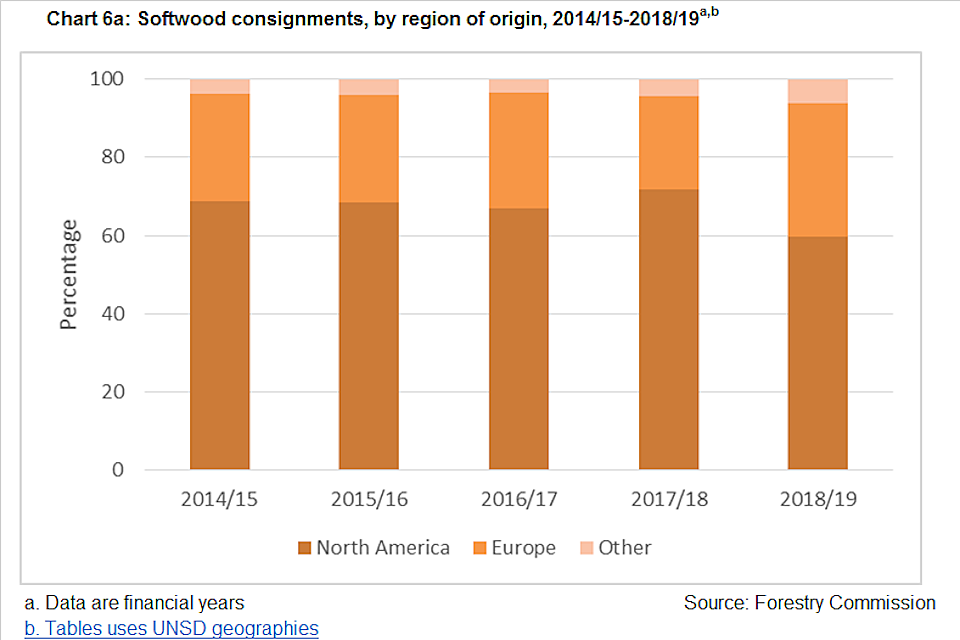
Chart 6a: Softwood consignments, number, by region of origin, 2014/15-2018/19. Data are financial year, show percentage of consignments from North America, Europe and Other, for each year between 2014/15 and 2018/19. Source: Forestry Commission.
6b. Volume of material

Chart 6b: Softwood consignments, volume, by region of origin, 2014/15-2018/19. Data are financial year, show percentage of consignments from North America, Europe and Other, for each year between 2014/15 and 2018/19. Source: Forestry Commission.
- Across the time period shown, the highest proportion of controlled softwood consignments originated in North America however the highest proportion of total softwood volume originated in Europe. This may reflect broader aspects of trade such as efficiency of the supply chain with smaller, but more numerous, consignments coming from North America.
- The proportion of controlled softwood consignments originating in North America stood at 68.7 per cent in 2014/15 but had decreased to 59.7 per cent in 2018/9. Despite the high number of consignments the volume of softwood material from North America accounted for only 25.5 of all controlled softwood in 2014/15, falling to 13.8 per cent in 2018/19.
- In contrast, controlled softwood consignments from Europe accounted for 27.5 per cent of all consignments and 73.1 per cent of all volume in 2014/15 increasing to 34.1 per cent of all consignments and 84.3 per cent of all volume in 2018/19.
Table 10: Controlled consignments of hardwood, by region of origin, 2014/15-2018/19
| 2014/15 | 2015/16 | 2016/17 | 2017/18 | 2018/19 | Value change 2014-2018 | Percentage change 2014-2018 | |
|---|---|---|---|---|---|---|---|
| Number of consignments | |||||||
| North America | 2,253 | 2,224 | 2,137 | 1,737 | 2,164 | -89 | -4.0 |
| Europe (non-EU) | 3 | - | - | * | 11 | 8 | 266.7 |
| Total | 2,256 | 2,224 | 2,137 | 1,737 | 2,175 | -81 | -3.6 |
| Volume of notified product (m3) | |||||||
| North America | 128,098 | 113,305 | 168,403 | 83,472 | 189,544 | 61,446 | 48.0 |
| Europe (non-EU) | 97 | - | - | * | 793 | 696 | 717.5 |
| Total | 128,195 | 113,305 | 168,403 | 83,472 | 190,337 | 62,142 | 48.5 |
Table 10 shows the number of controlled consignments of hardwood and the volume of material, notified to FC, by region of origin.
- The volume of controlled hardwood increased from 128,195m3 to 190,337m3 during the period 2014/15 to 2018/19 despite a small drop in the number of consignments (2,256 to 2,175).
- Almost all controlled consignments of hardwood originated in North America.
- The number of controlled consignments from North America decreased from 2,253 in 2014/15 to 2,164 in 2018/19 however the volume of material associated with these consignments increased from 128,098m3 to 189,544m3 during the time period.
Table 11: Controlled consignments of oak and ash timber, 2014/15-2018/19
| 2014/15 | 2015/16 | 2016/17 | 2017/18 | 2018/19 | Value change 2014-2018 | Percentage change 2014-2018 | |
|---|---|---|---|---|---|---|---|
| Number of consignments | |||||||
| Ash | 379 | 362 | 329 | 285 | 335 | -44 | -11.6 |
| Oak | 1,778 | 1,747 | 1,681 | 1,330 | 1,562 | -216 | -12.1 |
| Total | 2,157 | 2,109 | 2,010 | 1,615 | 1,897 | -260 | -12.1 |
| Volume of notified product (m3) | |||||||
| Ash | 13,288 | 13,141 | 13,538 | 10,537 | 11,531 | -1,757 | -13.2 |
| Oak | 57,120 | 55,305 | 109,695 | 41,524 | 140,852 | 83,732 | 146.6 |
| Total | 70,408 | 68,446 | 123,233 | 52,061 | 152,383 | 81,975 | 116.4 |
Ash originating in Canada, China, Japan, Mongolia, North Korea, South Korea, Russia, Taiwan and USA and Oak (Quercus suber) originating in the USA are both controlled and account for the majority of controlled hardwood imports.
- Oak and Ash accounted for 87.2 per cent of controlled hardwood consignments in 2018/19, having decreased from 95.6 per cent in 2014/15. These two species accounted for 80.1 per cent of the volume of controlled hardwood in 2018/19, an increase from 54.9 per cent in 2014/15.
- Oak accounted for 71.8 per cent of controlled hardwood consignments and 74.0 per cent of controlled material in 2018/19, a decrease from 2014/15 in controlled consignments (from 78.8 per cent) but an increase in the volume of controlled material (from 44.6 per cent).
Glossary
Commodity:
A type of plant, plant product, or other article being moved for trade or other purpose [FAO, 1990; revised ICPM, 2001]
Consignment:
A quantity of plants, plant products or other articles being moved from one country to another and covered, when required, by a single phytosanitary certificate (a consignment may be composed of one or more commodities or lots) [FAO, 1990; revised ICPM, 2001]. For PHSI data a consignment is a commodity type declared on a phytosanitary certificate. Some phytosanitary certificates will cover more than one commodity type and so the number of consignments declared will be more than the number of phytosanitary certificates.
Controlled plant products:
Plants and plant commodities which are required to undergo checks for pest and disease on crossing a customs border. For countries within the European Union (EU) this means upon entry to the EU while for countries.
Country of origin:
Country where the plants were grown [FAO, 1990; revised CEPM, 1996; CEPM, 1999]
Customs declaration:
An official document that lists and gives details of goods that are being imported or exported. In legal terms, a customs declaration is the act whereby a person indicates the wish to place goods under a given customs procedure. This legal procedure is described in the Union Customs Code (UCC) (Articles 5 (12) and 158 to 187).
Exports (HMRC trade data):
The country of destination as declared at the time of export. However, where goods can be traded while in transit (e.g. grain and crude oil), this may not necessarily be the final destination of the goods.
Food and crops:
Commodities traded for the primary purpose of human consumption.
Forestry:
Timber and wood commodities but not live trees.
Fruit:
The sweet and fleshy product of a tree or other plant that contains seed and can be eaten as food.
Hardwood:
Timber from broadleaved trees.
Imports (HMRC trade data):
The country from which the goods were originally dispatched to the UK without any commercial transaction in any intermediate country (either with or without breaking bulk in the course of transport). This is not necessarily the country of origin, manufacture or the last country from which the goods were shipped to the UK.
Inspection:
Official visual examination of plants, plant products or other regulated articles to determine if pests are present or to determine compliance with phytosanitary regulations [FAO, 1990; revised FAO, 1995; formerly “inspect”].
Non-EU European countries:
Countries outside of the European Union but geographically part of Europe.
‘Other’ commodities:
Plants and parts of plants (including seeds and fruits) used primarily in perfumery or pharmacy or for insecticidal, fungicidal or similar purposes.
Phytosanitary certificate:
An official paper document or its official electronic equivalent, consistent with the model certificates of the IPPC, attesting that a consignment meets phytosanitary import requirements [FAO, 1990; revised CPM, 2012]
Plants and plant commodities:
Goods including plants, trees, bulbs, seeds, fruit, vegetables and timber. Commodities are included if they are (1) raw plant products or (2) simply processed, i.e., processed in a manner that would not, in theory, remove the pest and disease risk.
Plants and planting material:
Live or dormant plants, seeds, bulbs or tubers of plants and trees and cut flowers.
Simple processing:
Simple processing can include peeling, grinding, chopping and debarking but excludes cooking, fermenting and preservation in liquid. For further information please see International Standards for Phytosanitary Measures; ISPM No. 32; Categorisation of commodities according to their pest risk (2009).
Softwood:
Timber from coniferous trees.
Vegetable:
A plant or part of a plant used as food, such as a cabbage, potato, turnip, or bean.
-
Includes raw products and those that can be defined as ‘simply processed’. Please see the glossary at the end of this document and the associated quality and methodology report for more information. ↩
-
Tree health legislation and [Plant health controls[(https://www.gov.uk/guidance/plant-health-controls). ↩
-
Plant Health is devolved thus Scotland carries out its own plant health inspections. ↩
-
Information on methodology and quality for HMRC overseas trade statistics can be accessed at: HMRC trade statistics - policies and methodologies ↩
-
Food Standards Agency - Multi-Annual National Control Plan ↩
-
Guidance on importing plants, fruit, vegetables, cut flowers and other regulated objects to the UK and Guidance on importing wood, wood products or bark from non-EU countries ↩
-
Guidance on issuing plant passports to trade plants in the EU and Guidance on importing and exporting wood and timber products ↩
-
Guidance on importing firewood and Guidance on importing or exporting wood packaging material ↩
